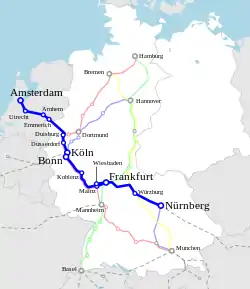Van Beethoven (train)
The Van Beethoven was an international train linking the Dutch capital Amsterdam and the West German capital Bonn. The train was named after the Bonn-born composer Ludwig van Beethoven.[1]
| Overview | |||||
|---|---|---|---|---|---|
| Service type | Trans Europ Express (TEE) (1972–1979) InterCity(IC) (1979– 2002) | ||||
| Locale | Germany Netherlands | ||||
| Predecessor | TEE Rhein - Main | ||||
| First service | 28 May 1972 | ||||
| Last service | 14 December 2002 | ||||
| Current operator(s) | Deutsche Bundesbahn Deutsche Bahn | ||||
| Technical | |||||
| Track gauge | 1,435 mm (4 ft 8 1⁄2 in) | ||||
| Electrification | 1500 V DC (Netherlands) 15 kV 16,7 Hz (Germany) | ||||
| |||||
The Van Beethoven was the successor of the TEE Rhein–Main on the same route and schedule. The route of the Rhein–Main was shortened to Amsterdam - Bonn in the autumn of 1971, thus ending the relation with the Main eventually resulting in renaming the TEE to Van Beethoven.[2] Travellers wanting to go to Frankfurt am Main in the evening could proceed from Bonn using the TEE Saphir arriving in Frankfurt eight minutes later than the former Rhein-Main.[3] On request of German members of parliament the route was extended to Nürnberg in 1976, resulting in an arrival around 1:30 a.m. In 1978 the Deutsche Bundesbahn decided to reinstate the Amsterdam Frankfurt service with timed connections to Nürnberg arriving at a decent time (23:58). On 26 May 1979 the Van Beethoven was converted in a two-class InterCity.[4] The Van Beethoven was continued as international service until 1983 and afterwards served several different routes in Germany until the end of 2002.[5]
References
- La Légende des TEE p. 326.
- Das grosse TEE Buch p. 74
- TEE Züge in Deutschland p. 79.
- TEE Züge in Deutschland p. 81.
- La Légende des TEE p. 328.
Works cited
- Hajt, Jörg (2001). Das grosse TEE Buch (in German). Bonn/Königswinter: Heel Verlag. ISBN 3-89365-948-X.
- Mertens, Maurice; Malaspina, Jean-Pierre (2007). La Légende des Trans Europ Express (in French). Vannes: LR Presse. ISBN 978-29-036514-5-9.
- Goette, Peter (2008). TEE-Züge in Deutschland (in German). Freiburg: EK-Verlag. ISBN 978-3-88255-698-8.

